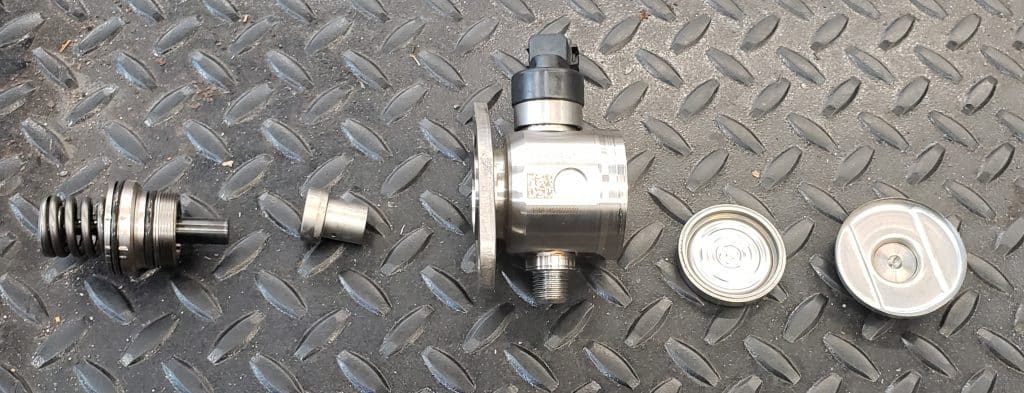Gasoline direct injection (GDI) offers some unique diagnostic and repair challenges compared to conventional fuel injection, but it’s not difficult to work with. It’s just different. We rely heavily on scan tool data when diagnosing direct injection, rather than direct measurement, so that’s one difference. And special tools are required to replace direct injectors, unlike conventional injectors which only require basic hand tools.
What’s the difference between direct injection and conventional fuel injection
Cars with port fuel injection systems have injectors that spray into the intake manifold close to the cylinder head, or directly above the intake valve in the cylinder head. On direct injection vehicles, the fuel injector is placed on the cylinder head and sprays directly into the combustion chamber.
What’s Better About Direct Injection
- More precise air/fuel ratio control: which has the following benefits:
- Improved fuel economy
- Lower emissions
- The ability to run higher compression or more boost
- Smoother idle and acceleration
- Better cold starts and drivability because fuel puddling is eliminated
- Rapid throttle response
- Better compatibility with alternative fuels like E85
What’s Worse About Direct Fuel Injection?
- Noise. The DI pump makes a gas engine sound a bit like a diesel. Most cars have noise shields to reduce the sound
- Injector failure. DI injectors seem to clog more frequently than conventional injectors
- Carbon buildup on the intake valves that requires periodic walnut shell blasting
- Motor oil dilution with fuel. Hopefully this will get better as the technology matures
- Timing chain wear (due to the additional stress on the chain from the DI pump)
- LSPI (low speed pre-ignition). A big problem for turbo engines and very expensive to repair
- Not ideal for high output / high performance engines
Toyota D-4S Direct Injection
Toyota created a great system that solved many of the issues with direct injection. It’s called D-4S and stands for “Direct-injection 4-stroke gasoline engine Superior version.” This system uses both direct injection and conventional fuel injection, so it’s able to retain all of the benefits of a DI system while reducing its downsides. It’s main advantages are:
- Solves the intake valve carbon issue
- Allows for higher output engines
- Interestingly, these engines do not seem to develop oil dilution issues
Direct Injection Carbon Buildup Symptoms
One of the most common problems for cars with direct injection is not a fault with the GDI system itself, but rather carbon buildup on the intake valves. Because the injectors don’t spray fuel on the intake valves like they do with conventional injection, and crankcase vapors are recycled through the intake back into the engine to be re-burned, intake valves on direct injection engines get very dirty and need to be cleaned periodically. Here are some of the symptoms of carbon buildup on the intake valves:
- Misfires / rough running at idle, especially when cold
- A valve sticking open causing a misfire and engine speed tapping noise, especially when cold
- Loss of engine power. This happens slowly and drivers may not notice until the power comes back after the cleaning
- Difficultly starting the engine
How Do We Diagnose Problems With GDI systems?
With conventional fuel injection, we use scan tools, fuel pressure gauges, oscilloscopes, and injector balance testing to find problems with the fuel injection system. When working with GDI systems, we typically only need a scan tool.
GDI systems typically have two pressure sensors that report to the engine control module. Using a scanner, we can check the pressure in the low pressure rail, which is created by the fuel pump in the fuel tank, and the pressure in the high pressure rail, which is created by the direct injection pump.
Low Low Pressure and Low High Pressure
If both the low pressure rail and the high pressure rail are low then there’s likely a problem with fuel delivery, like a bad low pressure fuel pump in the tank or clogged inlet screen.
Normal Low Pressure and Low High Pressure
If the low pressure rail is normal and the high pressure rail is low, then there’s likely an issue with the high pressure direct injection pump which is driven by the camshaft.
Normal Low Pressure and Normal High Pressure With a Misfire
If both rails are normal but the engine misfires, turn the engine off while leaving the key on and monitor the rail pressures. When everything is good with the injectors and the pump, the high pressure rail pressure will actually increase a bit due to the heat and the fuel being held in “sealed container”.
If pressure drops in the high pressure rail when the engine is off, either the pump check valve is leaking or one (or more) of the injectors is leaking.
Honda Civic High Pressure Direct Injection Fuel Pump Case Study
Honda’s “Earth Dreams” high-pressure direct injection fuel pumps are failing. I’ve heard this from dealer techs, but up until yesterday I hadn’t seen one come into our shop since most of these D.I. cars are still under warranty. Since I was curious about how the pump worked, I went ahead and disassembled it to take a look.
2015 Honda Fit cranks but won’t start
This particular pump came from a 2015 Honda Fit that rolled into the shop with extended cranking and extremely low power. The check engine light was on and it had set a P0087 code (fuel rail pressure too low) The ECM monitors the fuel rail pressure using a pressure transducer. Fuel pressure in live data is 29 PSI. This is what the in-tank pump generates, so the high-pressure pump was doing nothing at all.
What’s inside a direct injection pump?
Well, this pump certainly wasn’t meant to be disassembled. It’s pretty beefy and appears to be made of stainless steel. I’m certainly not going to be able to pry it open with a screwdriver.
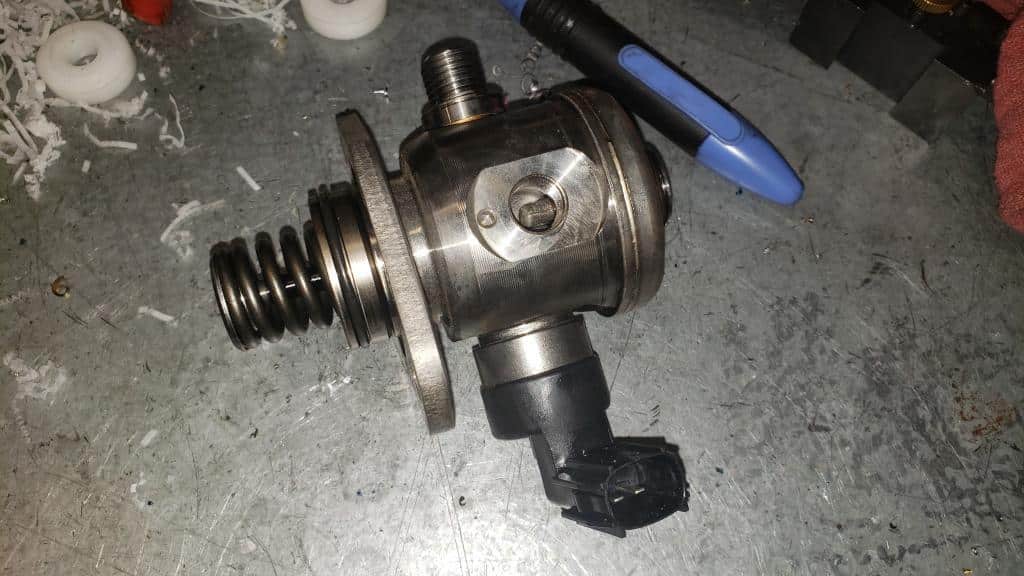
The top of the direct injection pump is welded to the top body, so I mounted in the lathe and cut through the top and weld joint.
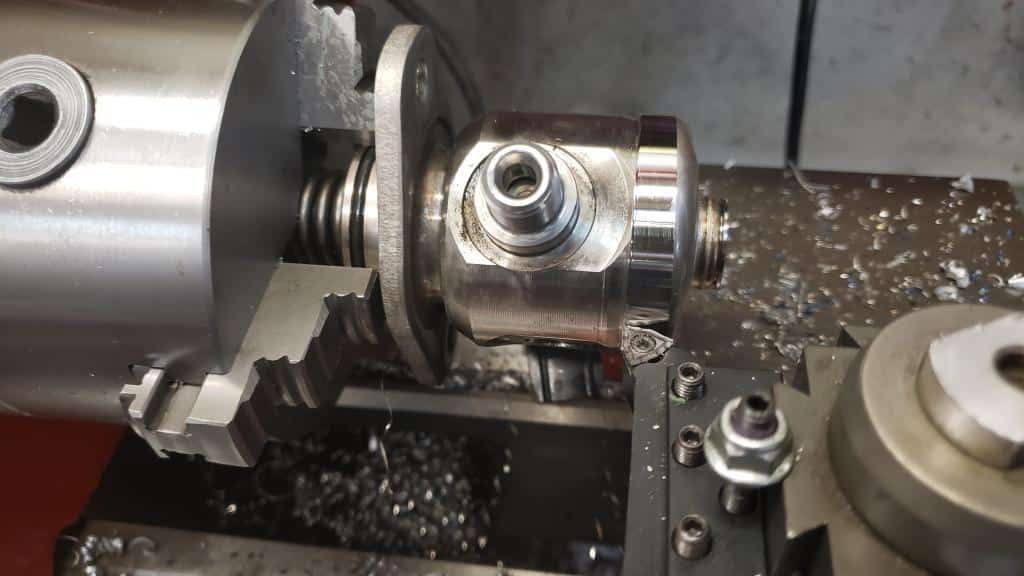
From left to right: piston, pushrod, and spring, cylinder, pump body with pressure control valve, damper, pump top.
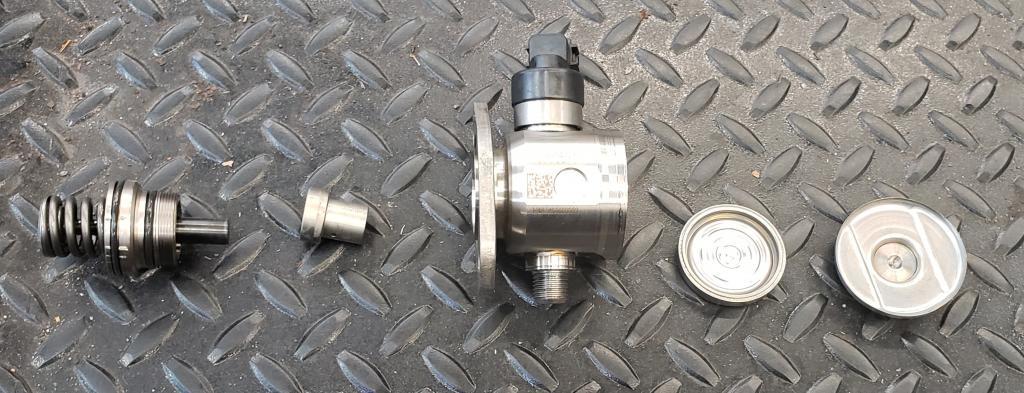
The bottom of pump contains a piston, pushrod, and spring. The spring retainer is held to the pushrod with shrink fit collar, so there’s no easy way to remove the spring to access the allen (not visible in the picture). Since this isn’t going back into a car, a pipe wrench did the trick.
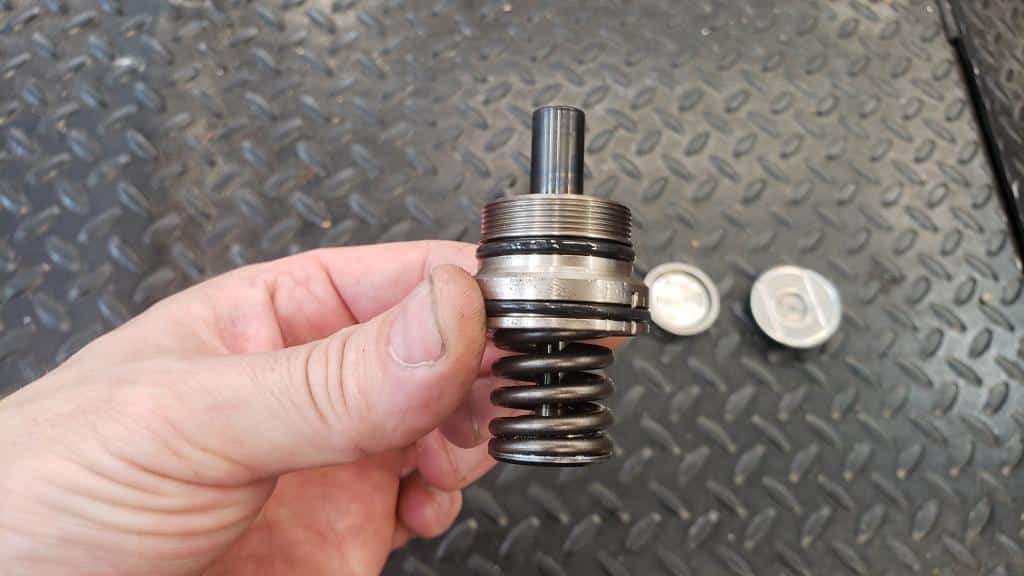
This is the top of the pump body with the damper removed. There’s an inlet screen in the top. What I first assumed is a pressure relief valve, but later discovered is a one way check valve responsible for maintaining fuel pressure in the rail when the pump isn’t pumping. A passage to the piston on the bottom. And two passages to the pressure regulator valve on the left.
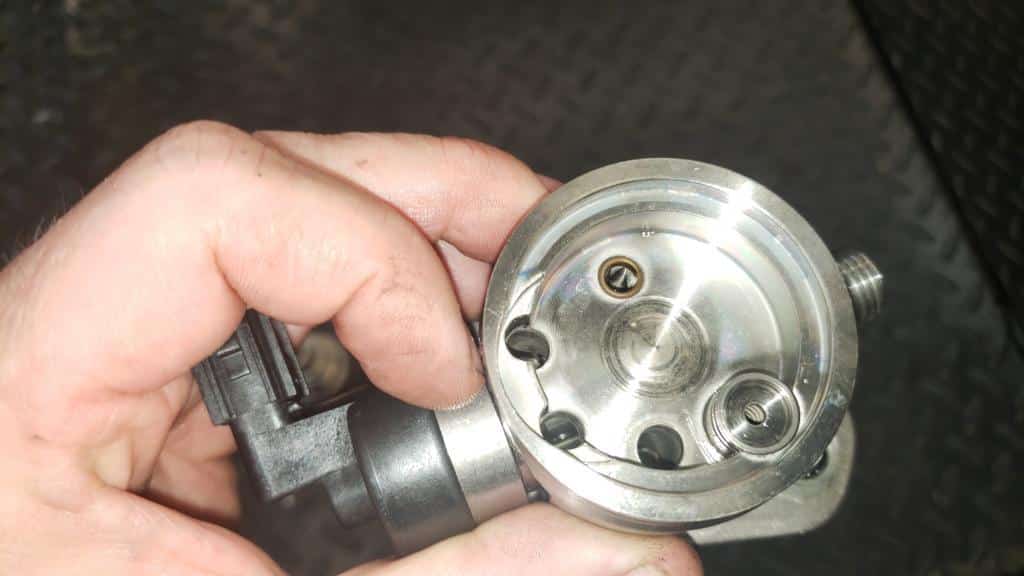
I assumed that the failure was the pressure regulator, since the piston and cylinder sleeve still seemed to have a nice fit, and the cam lobe and pusher were in good shape with 3mm of lift.
I’m just as dumb as when I started
In the end I wasn’t able to figure out how this pump works just by looking at it. Obviously there’s a piston that creates the pressure, but how is the pressure maintained? There’s only one check valve. It has a pressure regulator, but how does it regulate pressure? There are two passages that appear to be either opened or closed, but simultaneously. As far as I could tell, this pump shouldn’t work.
When all else fails, cheat
If all else fails, read the manual. Today any question can be answered in seconds by asking your phone. It takes the fun out of wondering and experimenting sometimes, but it’s nice to be able to flip to the back of the book and find the answer when you’re done struggling.
I found this video which does a great job of explaining how the pump works succinctly. (Credit to ADPTraining / Automotive Diagnostics and Publishing). The pump is both more simple and more complex than I realized. The pump itself is very simple. However, by itself it’s not a pump. Without computer control of the pressure regulator, it will not build any pressure. The complex part is the computer control.
The ECM opens and closes the pressure regulator in time with the position of the 4 lobe cam on the camshaft. During the piston downstroke the valve is open, allowing the cylinder to fill with fuel. When the piston starts to come up the the ECM closes the valve so the piston can develop pressure which is pushed past the check valve into the fuel rail. Pressure can be controlled changing the time when the valve closes. The closer to BDC the valve closes, the higher the pressure. If the valve is closed later into the upstroke, the pressure can be reduced.
When does the injector squirt?
Since this is a 4 cylinder engine, and direct injection pump cam is on the camshaft, the GDI pump piston makes one stroke per firing event. I imagine peak pressure is developed about the time the of the injection event.
To be honest I’m not sure when the injection event takes place. Fuel is injected directly into the combustion chamber. It doesn’t require the intake air flow to carry the fuel in. This would make it possible to change the D.I. injector timing from traditional port fuel injector timing. Maybe that will be my next experiment. I’ll set up a 4 channel scope to check the crank position, cam position, and injector firing pulse.
Other articles you may like:
Fuel injector cleaning
Prius catalytic converter hack
TIG welding a cracked cylinder head
Plastic Welding
